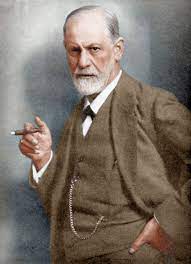Sigmund Freud’s Theories
Freud’s theories were enormously influential but subject to considerable criticism both now and during his life. However, his ideas have become interwoven into the fabric of our culture .
Freud’s theories include:

Unconscious mind:
This is one of his most enduring ideas, which is that the mind is a reservoir of thoughts, memories, and emotions that lie outside the awareness of the conscious mind.
Personality:
Freud proposed that personality was made up of three key elements: the id, the ego, and the superego. The ego is the conscious state, the id is the unconscious, and the superego is the moral or ethical framework that regulates how the ego operates.
The Id:
- According to Freud, the id is the source of all psychic energy, making it the primary component of personality.
- The id is the only component of personality that is present from birth.
- This aspect of personality is entirely unconscious and includes instinctive and primitive behaviors.
The id is driven by the pleasure principle, which strives for immediate gratification of all desires, wants, and needs. If these needs are not satisfied immediately, the result is a state anxiety or tension. For example, an increase in hunger or thirst should produce an immediate attempt to eat or drink.
The id is very important early in life because it ensures that an infant’s needs are met. If the infant is hungry or uncomfortable, they will cry until the demands of the id are satisfied. Young infants are ruled entirely by the id, there is no reasoning with them when these needs demand satisfaction.
Although people eventually learn to control the id, this part of personality remains the same infantile, primal force throughout life. It is the development of the ego and the superego that allows people to control the id’s basic instincts and act in ways that are both realistic and socially acceptable.
The Ego
- According to Freud, The ego develops from the id and ensures that the impulses of the id can be expressed in a manner acceptable in the real world.
- The ego functions in the conscious, preconscious, and unconscious mind.
- The ego is the component of personality that is responsible for dealing with reality
Freud compared the id to a horse and the ego to the horse’s rider. The horse provides the power and motion, while the rider provides direction and guidance. Without its rider, the horse may simply wander wherever it wished and do whatever it pleased. The rider gives the horse directions and commands to get it to go where the rider wants it to go.
The Superego
- According to Freud, the superego begins to emerge at around age five.
- The superego holds the internalized moral standards and ideals that we acquire from our parents and society (our sense of right and wrong).
- The superego provides guidelines for making judgments.
The superego has two parts:
- The conscience includes information about things that are viewed as bad by parents and society. These behaviors are often forbidden and lead to bad consequences, punishments, or feelings of guilt and remorse.
- The ego ideal includes the rules and standards for behaviors that the ego aspires to.
The superego tries to perfect and civilize our behavior. It works to suppress all unacceptable urges of the id and struggles to make the ego act upon idealistic standards rather that upon realistic principles. The superego is present in the conscious, preconscious, and unconscious.
Life and death instincts:
Freud claimed that two classes of instincts, life and death, dictated human behavior. Life instincts include sexual procreation, survival and pleasure; death instincts include aggression, self-harm, and destruction.
Psychosexual development:
Freud’s theory of psychosexual development posits that there are five stages of growth in which people’s personalities and sexual selves evolve. These phases are the oral stage, anal stage, phallic stage, latent stage, and genital stage.
Mechanisms of defense:
Freud suggested that people use defense mechanisms to avoid anxiety. These mechanisms include displacement, repression, sublimation, and regression.
Sigmund Freud and Psychoanalysis
Freud’s ideas had such a strong impact on psychology that an entire school of thought emerged from his work: psychoanalysis. Psychoanalysis has had a lasting impact on both the study of psychology and the practice of psychotherapy.
Research has found that psychoanalysis can be an effective treatment for a number of mental health conditions. The self-examination that is involved in the therapy process can help people achieve long-term growth and improvement.